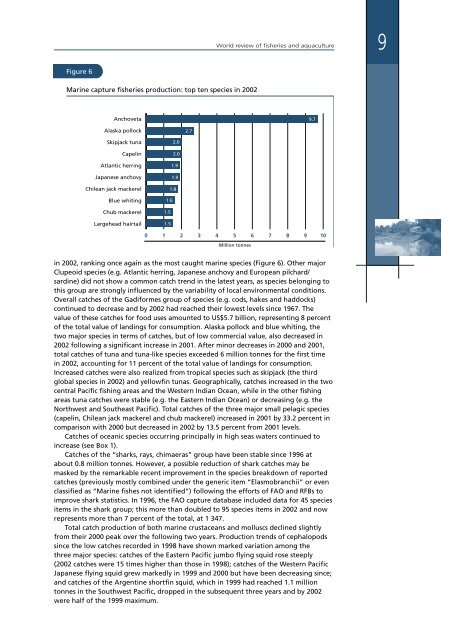State of World Fisheries and Aquaculture 2004 - Library
State of World Fisheries and Aquaculture 2004 - Library
State of World Fisheries and Aquaculture 2004 - Library
You also want an ePaper? Increase the reach of your titles
YUMPU automatically turns print PDFs into web optimized ePapers that Google loves.
<strong>World</strong> review <strong>of</strong> fisheries <strong>and</strong> aquaculture<br />
9<br />
<br />
<br />
<br />
<br />
<br />
<br />
<br />
<br />
<br />
<br />
<br />
<br />
<br />
<br />
<br />
<br />
<br />
<br />
<br />
<br />
<br />
<br />
<br />
<br />
in 2002, ranking once again as the most caught marine species (Figure 6). Other major<br />
Clupeoid species (e.g. Atlantic herring, Japanese anchovy <strong>and</strong> European pilchard/<br />
sardine) did not show a common catch trend in the latest years, as species belonging to<br />
this group are strongly influenced by the variability <strong>of</strong> local environmental conditions.<br />
Overall catches <strong>of</strong> the Gadiformes group <strong>of</strong> species (e.g. cods, hakes <strong>and</strong> haddocks)<br />
continued to decrease <strong>and</strong> by 2002 had reached their lowest levels since 1967. The<br />
value <strong>of</strong> these catches for food uses amounted to US$5.7 billion, representing 8 percent<br />
<strong>of</strong> the total value <strong>of</strong> l<strong>and</strong>ings for consumption. Alaska pollock <strong>and</strong> blue whiting, the<br />
two major species in terms <strong>of</strong> catches, but <strong>of</strong> low commercial value, also decreased in<br />
2002 following a significant increase in 2001. After minor decreases in 2000 <strong>and</strong> 2001,<br />
total catches <strong>of</strong> tuna <strong>and</strong> tuna-like species exceeded 6 million tonnes for the first time<br />
in 2002, accounting for 11 percent <strong>of</strong> the total value <strong>of</strong> l<strong>and</strong>ings for consumption.<br />
Increased catches were also realized from tropical species such as skipjack (the third<br />
global species in 2002) <strong>and</strong> yellowfin tunas. Geographically, catches increased in the two<br />
central Pacific fishing areas <strong>and</strong> the Western Indian Ocean, while in the other fishing<br />
areas tuna catches were stable (e.g. the Eastern Indian Ocean) or decreasing (e.g. the<br />
Northwest <strong>and</strong> Southeast Pacific). Total catches <strong>of</strong> the three major small pelagic species<br />
(capelin, Chilean jack mackerel <strong>and</strong> chub mackerel) increased in 2001 by 33.2 percent in<br />
comparison with 2000 but decreased in 2002 by 13.5 percent from 2001 levels.<br />
Catches <strong>of</strong> oceanic species occurring principally in high seas waters continued to<br />
increase (see Box 1).<br />
Catches <strong>of</strong> the “sharks, rays, chimaeras” group have been stable since 1996 at<br />
about 0.8 million tonnes. However, a possible reduction <strong>of</strong> shark catches may be<br />
masked by the remarkable recent improvement in the species breakdown <strong>of</strong> reported<br />
catches (previously mostly combined under the generic item “Elasmobranchii” or even<br />
classified as “Marine fishes not identified”) following the efforts <strong>of</strong> FAO <strong>and</strong> RFBs to<br />
improve shark statistics. In 1996, the FAO capture database included data for 45 species<br />
items in the shark group; this more than doubled to 95 species items in 2002 <strong>and</strong> now<br />
represents more than 7 percent <strong>of</strong> the total, at 1 347.<br />
Total catch production <strong>of</strong> both marine crustaceans <strong>and</strong> molluscs declined slightly<br />
from their 2000 peak over the following two years. Production trends <strong>of</strong> cephalopods<br />
since the low catches recorded in 1998 have shown marked variation among the<br />
three major species: catches <strong>of</strong> the Eastern Pacific jumbo flying squid rose steeply<br />
(2002 catches were 15 times higher than those in 1998); catches <strong>of</strong> the Western Pacific<br />
Japanese flying squid grew markedly in 1999 <strong>and</strong> 2000 but have been decreasing since;<br />
<strong>and</strong> catches <strong>of</strong> the Argentine shortfin squid, which in 1999 had reached 1.1 million<br />
tonnes in the Southwest Pacific, dropped in the subsequent three years <strong>and</strong> by 2002<br />
were half <strong>of</strong> the 1999 maximum.

















